EXPEDITION NOTES

Unalaska, Alaska, is the chief center of population in the Aleutian Islands.
Field Technician Needed for TV Documentary Set in AleutiansA television production company with a track record of hit shows on A&E, Discovery, History, Netflix, Travel Channel and many other networks is looking to cast a science or field technician for an upcoming show.
The ideal candidate must have on-hand experience with magnetometers, drones and other surveying equipment. A knowledge of Arctic or Alaskan terrain is preferred, but not required. This is an opportunity to be a part of a three- to four-week expedition in the Aleutian islands looking for lost artifacts. The goal of the expedition is to highlight the great history of the area, and hopefully uncover some truly unique finds. The production company prides itself on authentic story-telling with great characters and is not looking to fabricate drama.
For more information: casting10560@gmail.com

5G Comes to Everest
Base camp at Mount Everest now has 5G coverage, thanks to China Mobile. However, even at 5364m above sea level (17,598 ft.), this is not the highest place on Earth that you can get a 5G connection - currently that is the Intermediate Camp at 5800m, according to the mobile technology website GSMArena.com (April 21).
To honor its 20th anniversary, China Mobile overhauled the 177 km transmission line that connects Base Camp to its main network. This line now powers three 5G base stations and three 4G ones. Eight tons of networking equipment were hauled up, which also allowed CM to also build two 5G base stations at the Intermediate camp.
The new high-speed connection can be used to broadcast video live from the camps whether it's day or night. Two more 5G base stations were also being installed to operate at the Advanced Base Camp at 6500m (21,325 ft.).
Here's a quick history of cell coverage on Mount Everest: the first 3G connection from Base Camp was established in late October of 2010, allowing video calls. A few months later in 2011 a tweet from Everest was sent out from a Samsung Galaxy S II (which also starred in the world's highest unboxing video). This wasn't the first tweet from the summit, that one came in 2010 via satellite. In 2013, China Mobile flipped the switch on the first 4G tower in Base Camp and demonstrated a live video stream in HD.
Reader comments below the story were none too kind. Says Cyber, "useless amount of junk, people persistently continue to pollute every corner of the earth."
Posthc piles on with: "Rich Sport Rich Trip Rich Stuff and No local people will use 5g."
Ouch.
Read the full story and watch the drone sizzle reel here:
https://tinyurl.com/everest5G

Some food containers bearly pass
Smarter Than the Av-er-age Bear A recent story in Costco Magazine about the Bear-Resistant Products Testing Program at the Grizzly & Wolf Discovery Center in West Yellowstone, Montana, sparked our interest. Bears are given garbage cans, coolers and other food containers for an hour to see if they can bat, claw, bite, flip, or smash they way in. One technique bears like to use is a CPR maneuver as they explore weaknesses in a container.
Only products that withstand 60 full minutes of a 700-pound bear mauling receive a valuable stamp of approval from the federal Interagency Grizzly Bear Committee (IGBC) certifying them as bear-resistant. Keeping bears out of human food and garbage is the best way to ensure their survival in the wild.
This testing protocol allows consumers, parks and municipalities to obtain products that they know will work to keep human food and garbage inaccessible to bears and keep them out of conflict with people.
Watch a bear perform cooler CPR here:
https://www.greatbigstory.com/stories/bears-as-product-testers
QUOTE OF THE MONTH
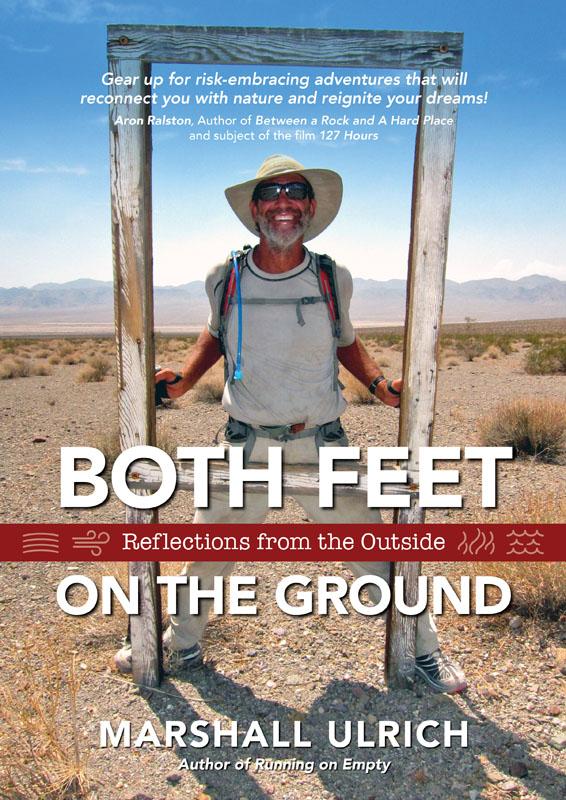
"[Nature] causes me to reflect on those precious people in my life, amplifying how much they matter to me . . . my mind ranges over them much like the mountains in my memory, too, each alike but unique.... Every day, especially every day outside in nature, is another chance at redemption."
- Author and endurance athlete Marshall Ulrich writing in Both Feet on the Ground: Reflections from the Outside (DNA Books, 2019). Ulrich is an extreme endurance athlete - ultrarunning icon, Seven Summits mountaineer, and adventure racer. He's raced, led expeditions, or climbed mountains in nearly 30 countries, and visited 30 more. He uses his adventures to drive home a very powerful message especially suited to today's shelter in place orders: "Get out and stay out - as often and for as long as you can."
For more information:
www.marshallulrich.com
EXPEDITION FOCUS
NASA Shuttle Flight Director: "We Built That"
For 33 years, Paul Dye, the featured speaker at an Explorers Club dinner, worked in increasingly responsible roles within the U.S. (NASA) Manned Space Program, both as a technical expert in spacecraft systems and, eventually, as the overall lead of many missions to space. He retired from NASA in 2013 as the longest-serving Flight Director in U.S. history.
Dye said he was hired by the legendary Gene Kranz, the crew-cutted NASA Flight Director in the homemade, five-button, off-white vest portrayed in the Apollo 13 movie by actor Ed Harris. "The Flight Director has ultimate authority over a flight and no one can take that away from him," Dye said.

No Handshaking Allowed - The Spock salute was de
rigueur at a Mar. 13 presentation when former NASA Flight Director Paul
Dye, was joined by Explorers Club members Mike Seibert (left), who spent
12 years working on the operations team for the twin Mars rovers
Spirit and Opportunity, and Alan Stern (right) principal investigator of the New Horizons mission to Pluto.
Dye's Flight Director career spanned both the space shuttle and International Space Station programs. The winner of many prestigious awards including the Johnson Space Center Director's Commendation, the NASA Outstanding Leadership Medal, and four NASA Exceptional Service Medals, Dye delighted in bringing the lessons learned from the most advanced flight operations back to the next generation of space operation professionals and to general aviation pilots and builders.
"Everybody is important right down to the people who design the nuts and bolts on the spacecraft," Dye said. "In fact, nobody on the team received a mission patch until Olga, our janitor, received hers."
Among his more humorous anecdotes is the story of the pneumatic tubes that transported documents within the Houston Mission Control Center (MCC). "They were only designed to transport a maximum of three ounces of paper, but engineers being engineers, we had to test the system. Someone packed a tube with pencils and we wound up removing splinters for a while," Dye said.
The team's staple diet was pizza, donuts and kolaches, a Czech breakfast food comprised of sweet bread filled with various breakfast items. Dye hoisted "Skinny Black Tie and White Shirt Days" in honor of early scenes of the MCC during the Apollo era, and tried to find the most annoying music possible with which to wake up astronaut crews. Touchingly, they played the Charlie Brown theme song when NASA supporter and cartoonist Charles Schultz died in 2000.

To this day, the Silver Snoopy Award, a sterling silver Snoopy lapel pin that has flown in space, symbolizes the intent and spirit of Space Flight Awareness. An astronaut always presents the Silver Snoopy because it is the astronauts' own award for outstanding performance, contributing to flight safety and mission success.
Dye will often check when the International Space Station is flying over his Nevada backyard, then go watch it overhead, remembering fondly, "We built that .... It's kind of a neat feeling.
"I learned the game from Apollo veterans so it was my honor to pass down knowledge to younger teams who will eventually control future flights to the moon and Mars."
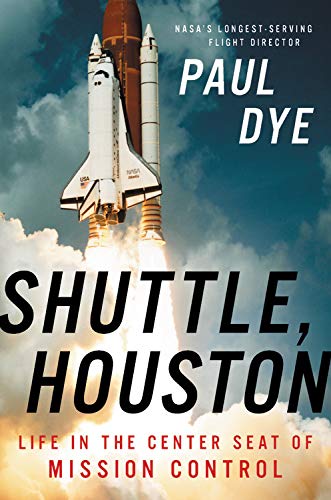
Dye's forthcoming book, Shuttle Houston: Life in the Center Seat of Mission Control (Hachette Books, 2020), tells the stories of flying human beings in space, and developing and executing missions to conduct science, deploy payloads, and build structures in space.

Backdropped
by a blue and white part of Earth, the International Space Station is
featured in this image photographed by an STS-130 crew member on space
shuttle Endeavour after the station and shuttle began their
post-undocking relative separation. Undocking of the two spacecraft
occurred at 7:54 p.m. (EST) on Feb. 19, 2010
In related news, you can view the International Space Station as it
soars above your own backyard, a great diversion if you're
self-quarantined. Spot The Station is a free on-line alert service that allows you to watch the International Space Station pass overhead from several thousand worldwide locations. It is the third brightest object in the sky and easy to spot if you know when to look up. Visible to the naked eye, it looks like a fast-moving plane only much higher and traveling thousands of miles an hour faster.
You can sign up here:
https://spotthestation.nasa.gov
MEDIA MATTERS

Eba, an approximately 5-year-old Jack-Russell terrier mix, sniffs at the breeze.
Silver Lining: Pandemic and Poop-Sniffing Dogs Gives Whales a BreakAmerican and Canadian marine scientists - and one talented dog - are seizing an unexpected opportunity presented by the coronavirus pandemic. They are trying to establish whether Pacific Northwest whales benefit from the current drop in boat traffic and underwater noise.
Stay-home edicts have significantly reduced recreational boat trips and ferry crossings this spring. Commercial whale watching tours and the cruise ship season remain on hold. Large cargo ships continue to come and go with slightly reduced frequency, according to Northwest News Network's Tom Banse on KUOW NPR (May 11).
Noise and vessel disturbance are considered major factors in the decline of the Northwest's endangered resident orcas alongside the other big factors of dwindling food supply - chiefly, chinook salmon - and toxic pollution.
"From a killer whale's perspective, not having fast moving boats around like recreational boats... that might be quite beneficial," said oceanographer Scott Veirs of Seattle, who coordinates an underwater microphone network called Orcasound.
A dog named Eba, trained at the University of Washington, is used to locate whale scat from up to a mile away. Often to check on whales without disturbing or capturing them, researchers need to collect poop samples, which contain valuable information about their health. Eba gets to play with her favorite tug toy as a reward for finding floating whale poop.
Listen to the story here:
https://www.kuow.org/stories/pandemic-gives-pacific-northwest-whales-a-respite-from-din-of-underwater-noise

Explorers Club members: Oh the tales they could tell. (Felix Kunze photo)
Tales From The Explorers Club Avenue Magazine tells some tales of The Explorers Club in a story by Angela M.H. Schuster (April 1). She writes, "Commissioned in 1910 as a family home for Singer Sewing Machine magnate and art collector Stephen C. Clark, the (Explorers Club's) five-story townhouse exudes an Old-World grandeur, appointed with stained glass windows and stone statues and columns plucked from medieval monasteries throughout the Low Countries and France.
"Among the latter is a formidable statue of Joan of Arc on horseback, which graces a massive mantel in the second-floor lecture hall. Many of the club's members find it ironic that St. Joan had presided over decades' worth of club meetings before women were admitted in 1981."
Schuster continues, "Among the other notable curiosities are a stuffed cheetah from Teddy Roosevelt's 1909 Smithsonian expedition; a globe upon which Thor Heyerdahl plotted the route for his 1947 voyage aboard Kon-Tiki; and the cartilage of a whale's penis, its size serving to keep a certain amount of club members' braggadocio in check."
She says Club membership rolls stand at 3,500 worldwide, with 600 members based in the New York area, and the rest belonging to some 33 chapters, including the most recent addition, an outpost in Bhutan. Over the past decade, the club has seen a demographic shift downward in terms of the age of its members, with a number of young scientists and adventurers joining the fold.
Read the story here:
https://avenuemagazine.com/tales-from-the-explorers-club/

Marabar by Elyn Zimmerman would be removed from a plaza in Washington as part of a plan by National Geographic to expand its headquarters. (Photo: Elyn Zimmerman Studio)
Critics Want NatGeo Stone Left UnturnedExplorers affiliated with the National Geographic Society have a long history of surmounting stone in places like Mount Everest. But the 130-year-old organization has decided that more than a million pounds of artfully placed granite are in the way of plans to expand its headquarters in Washington, according to a New York Times story by Rebecca J. Ritzel (May 9).
The boulders, part of a sculpture called Marabar, by Elyn Zimmerman, were installed by the society almost four decades ago in an outdoor plaza at its four-building campus.
But now, to make room for a new entrance pavilion and a rentable rooftop garden, National Geographic plans on dismantling the sculpture after Zimmerman was unable to find a new home for it.
The decision has drawn letters of complaint from architects, art critics, museum leaders and others who say they fear the loss of an important work.
Zimmerman said National Geographic had to take elaborate measures to prepare the site for the weight of the granite stones. "The largest of those boulders weighs a quarter of a million pounds," she said. "They're going to have to dynamite the thing out of there. "
Read the story here:
https://tinyurl.com/natgeostones
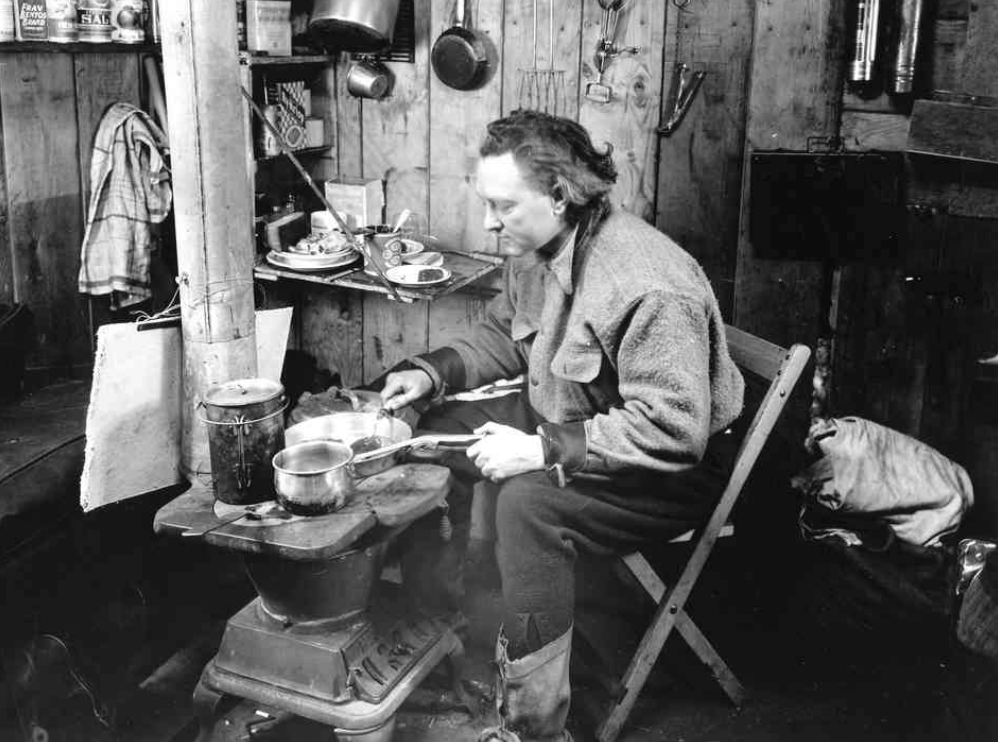
Byrd's oil-burning stove emitted toxic fumes. It also looks like he could use a haircut - like many of us these days.
How Did Richard E. Byrd Self-Quarantine? (Hint: Not Well)None of our days of self-quarantine approaches what Adm. Richard E. Byrd, the American arctic explorer, endured in 1934, when he spent five months alone in a one-room shack in Antarctica, wintering over the long night, writes Dennis Overbye in the New York Times (May 5).
Byrd's account of his 1934 ordeal, Alone, published in 1938, was written once Byrd was already famous for having been the first person to fly over the North Pole (although some researchers have disputed that claim) and, later, over the South Pole. He had received three ticker tape parades on Broadway.
"On his second expedition to Antarctica, from 1933 to 1935, Byrd, accompanied by a crew of more than four dozen men, sled dogs and a cow, hoped to increase the scope of his efforts from his established base on the coast, called Little America, into the interior of the continent, where the weather dynamics were unknown.
"He hit on the idea of wintering over through the entire dark Antarctic night, from April to October, to make meteorological and other scientific measurements. The Advance Base that Byrd and his crew eventually established was 178 miles away - a treacherous, crevasse-laden journey across the Ross Ice Shelf," Overbye writes in the Times.
In the book, Byrd conceded that he hungered for the ultimate solitude. There were all those books he wanted to read. He brought a windup record player with him, so he could listen to classical music.
Much of Alone is a testament to the idea that you should be careful what you wish for. A month in, he realized that he was being poisoned by the fumes from his oil-burning stove. "What I had not counted on was discovering how closely a man could come to dying and still not die, or want to die," he wrote in the opening pages of his memoir.
Every day he had to decide: run the stove to stay warm, and possibly suffocate because of the fumes, or breathe safely and risk freezing. He later claimed that the ordeal had humbled him such that he handed over command of his next adventure flight to a younger colleague, according to Overbye's story.
Read it here:
https://www.nytimes.com/2020/05/05/science/antarctica-byrd-distancing-expedition.html

Alex Honnold is Prudent
When asked about his thoughts on "Prudence," professional rock star rock climber Alex Honnold tells WSJ Magazine (May 2020): "The constant reflection on mortality (that comes from climbing) encourages you to live your life as fully and as completely as possible. Part of being a professional climber is to know the right tool for the right situation and to minimize risk as you can."
Read more of his comments here:
https://www.wsj.com/articles/carey-mulligan-stiff-lip-11580330268
EXPEDITION FUNDING

Explorers
Club Member Victor Vescovo and the Five Deeps Expedition Team Launching
the Limiting Factor on its way to the Mariana Trench - which will be
featured on Discovery (Photo by Tamara Stubbs)
Explorers Club Discovery Grants Open to AllApplications are being accepted for the $1 million "Explorers Club Discovery Expedition Grant" program to further advance significant exploration and scientific discovery. Final candidates for the grants will be selected by an independent panel of accomplished explorers, researchers, and academic scholars, including six renowned Ph.D. scientists, in conjunction with both The Explorers Club and Discovery. Explorers and adventurers anywhere can apply; they need not be a member of the Club, as was previously communicated to membership. However, applicants are welcome and encouraged to apply for membership.
The Grant program will allow explorers to share their findings on Discovery Channel television and digital platforms, in addition to explorers sharing their findings and discoveries in an array of scientific journals highlighting their accomplishments.
For more information:
https://tinyurl.com/Discoverygrants, grants@explorers.org
WEB WATCH

"Explore" the Weather In Your Backyard
Explorers chomping at the bit to resume field research, and weather nerds everywhere, are invited to become citizen scientists. The NOAA National Severe Storms Laboratory is collecting public weather reports through a free app available for smart phones or mobile devices. The app is called "mPING," for Meteorological Phenomena Identification Near the Ground.
mPING reports are immediately archived into a database at The University of Oklahoma, and are displayed on a map accessible to anyone.
To use the app, reporters select the type of weather that is occurring, and tap "submit," which seems to us a lot more interesting than piecing together yet another COVID-era jigsaw puzzle on the kitchen table. The anonymous reports can be submitted as often as every minute.
Weather radars cannot "see" at the ground, so mPING reports are used by the NOAA National Weather Service to fine-tune their forecasts. NSSL uses the data in a variety of ways, including to develop new radar and forecasting technologies and techniques.
The mPING app was developed through a partnership between NSSL, the University of Oklahoma and the Cooperative Institute for Mesoscale Meteorological Studies and was included in Scientific American's list of "8 Apps That Turn Citizens into Scientists."
Learn more:
https://mping.nssl.noaa.gov/

Everest without the altitude: Dr. Arun Nayak in his Mumbai stairwell
Lockdown Madness: Everest By Staircase Climbers on lockdown worldwide have started to go stir crazy, as evidenced by Mumbai orthodontist Arun Nayak who decided to climb Everest's height within his 47-story apartment house - all 2,950 floors accomplished without breaking self-quarantine guidelines.
In a video posted by the Indian Mountaineering Foundation, you can see how Nayak, an amateur mountaineer and long distance runner, monitored his progress. He enlisted his wife during the final ascent. He reports the 20-1/2 hour, three-day effort was - no surprise here - hot, humid, boring and monotonous.
See the video here:
https://tinyurl.com/lockdownmadness
EXPEDITION CLASSIFIEDS
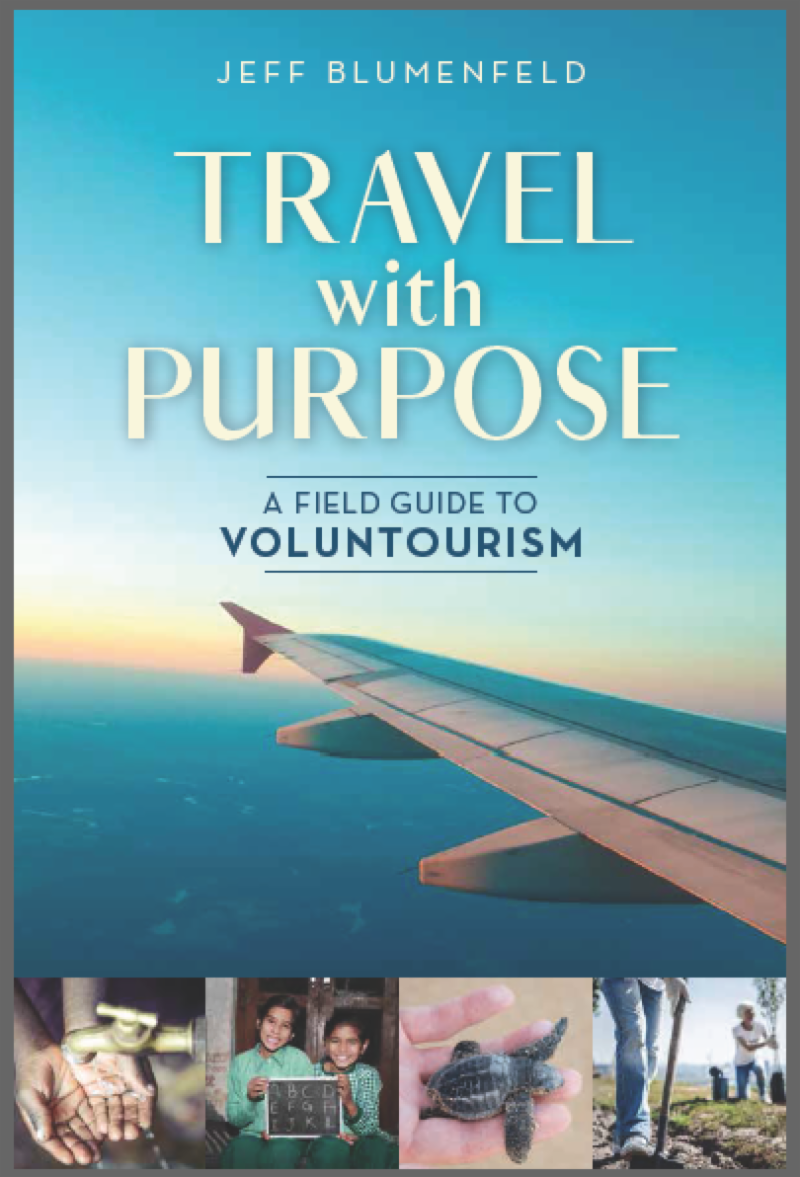
Travel With Purpose, A Field Guide to Voluntourism
(Rowman & Littlefield, April 2019) by Jeff Blumenfeld
- How to travel and make a difference while you see the world? These
are stories of inspiration from everyday voluntourists, all of whom have
advice about the best way to approach that first volunteer vacation,
from Las Vegas to Nepal, lending a hand in nonprofits ranging from
health care facilities, animal shelters and orphanages to impoverished
schools. Case studies are ripped from the pages of Expedition News, including the volunteer work of Dooley Intermed, Himalayan Stove Project, and even a volunteer dinosaur dig in New Jersey.
Read excerpts and "Look Inside" at: tinyurl.com/voluntourismbook @purpose_book
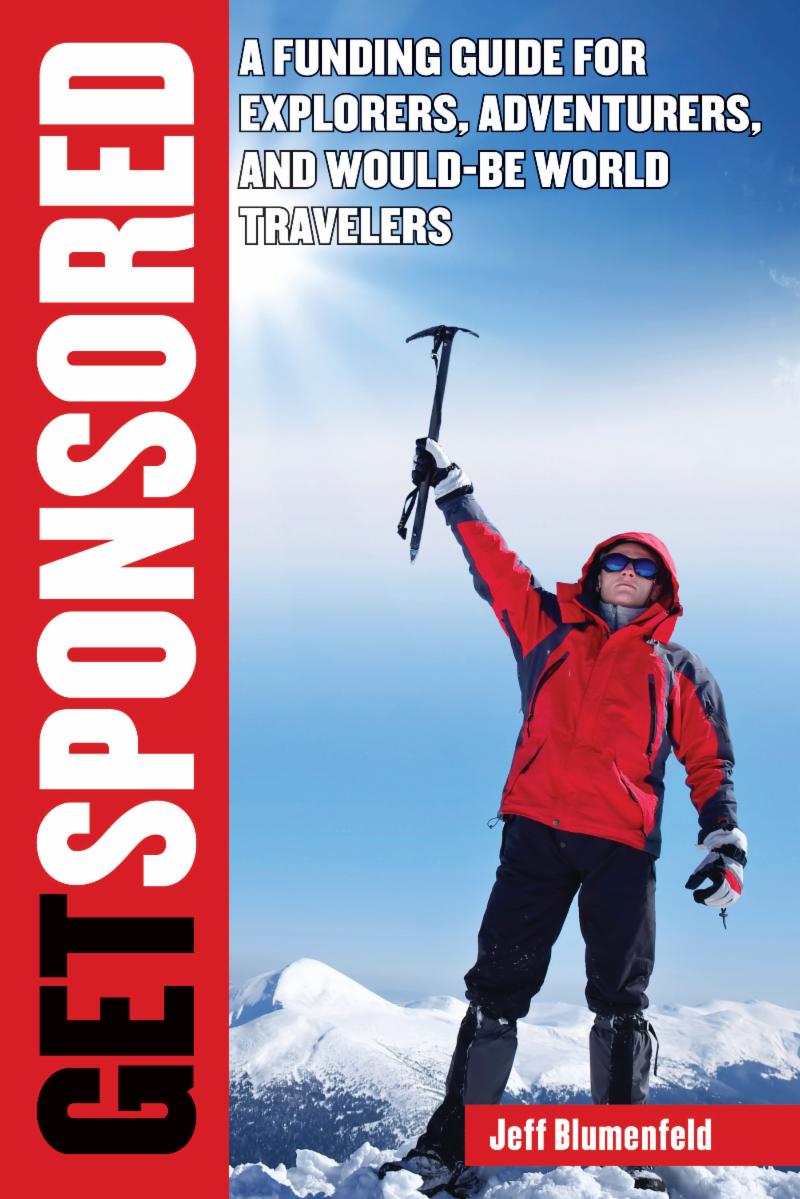
Get Sponsored! - Hundreds of
explorers and adventurers raise money each month to travel on world
class expeditions to Mt. Everest, Nepal, Antarctica and elsewhere. Now
the techniques they use to pay for their journeys are available to
anyone who has a dream adventure project in mind, according to the book
from Skyhorse Publishing called: Get Sponsored: A Funding Guide for Explorers, Adventurers and Would Be World Travelers.
Author Jeff Blumenfeld, an adventure marketing specialist who
has represented 3M, Coleman, Du Pont, Lands' End and Orvis, among
others, shares techniques for securing sponsors for expeditions and
adventures.
Buy it here:
Advertise in Expedition News - For more information: blumassoc@aol.com
EXPEDITION NEWS is published by Blumenfeld and Associates, LLC, 290 Laramie Blvd., Boulder, CO 80304 USA. Tel. 203 326 1200, editor@expeditionnews.com.
Editor/publisher: Jeff Blumenfeld. Research editor: Lee Kovel. ©2020
Blumenfeld and Associates, Inc. All rights reserved. ISSN: 1526-8977.
Subscriptions: US$36/yr. available by e-mail only. Credit card payments
accepted through www.paypal.com payable to Blumassoc@aol.com.
Read EXPEDITION NEWS at www.expeditionnews.com. Enjoy the EN blog at www.expeditionnews.blogspot.com.


